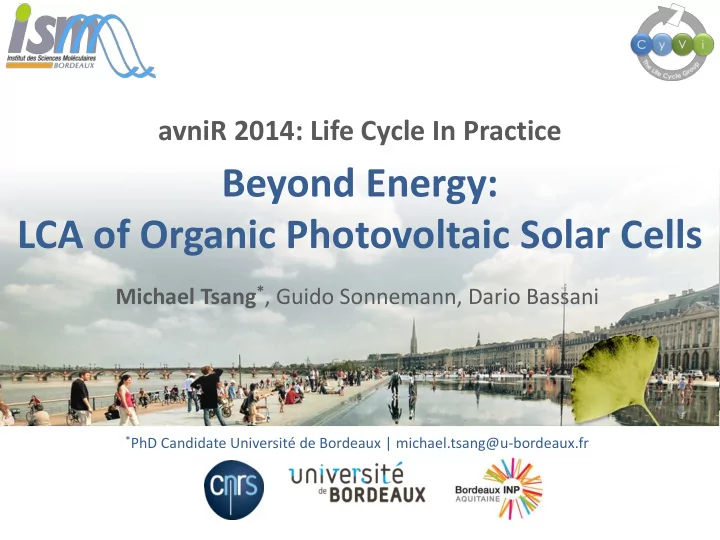

avniR 2014: Life Cycle In Practice Beyond Energy: LCA of Organic Photovoltaic Solar Cells Michael Tsang * , Guido Sonnemann, Dario Bassani * PhD Candidate Université de Bordeaux | michael.tsang@u-bordeaux.fr 1
Outline • Photovoltaics • Organic Photovoltaics • LCA: Methods • LCA: Results • Sensitivity Analysis • Comparison to Conventional Cells • Conclusions 2
Photovoltaics • General PV Technology: conversion of light energy to electrical energy – Semiconductor absorbs light, ‘‘knocking’’ loose electrons which create electricity (in a circuit) Photo Credits: www.solarcell.net 3
Organic Photovoltaics Photo Credits: www.phys.org • Third generation solar technology, organic materials act as semiconductor 4
Organic Photovoltaics Solar Cell-Efficiencies (Research Scale) Embodied Energy of Organic and Other PV Cells Organic Other Thin Films 35 Garcia-Valverde (Glass) Roes et al (Glass) 30 Espinosa et al 2011 (PET) 25 Espinosa et al 2001 (PET) Anctil et al 2012 (PET) Energy (MJ) 20 Anctil et al 2010 (PET) Roes et al (PET) 15 Espinosa et al 2012 (PET) Dye-S (Roes et al ) 10 CdTe (Roes et al) a-Si (Laminate) 5 m-Si (Laminate) CIS (Roes et al) 0 Literature Photo Credits: NREL 5
Motivation for the Study • Objective: prospective assessment of the environmental profile of organic photovoltaics using roll-to-roll technology • Part of a larger LCA to understand the environmental and human health impacts from organic photovoltaics from cradle-to- grave 6
LCA: Goal and Scope • Cradle-to-Gate • Functional Unit: 1 watt-peak (Wp); power output under standard testing conditions • Sensitivity Analysis • Comparison to Conventional Photo Credits: gelifesciences.com Cells 7
LCA: System Boundaries • Inventory data from scientific literature, stoichiometric calculations, and Ecoinvent • Ecoinvent 2.2 | ReCiPe v1.0.5 Midpoint (H) | openLCA 1.4 8
LCA: Results 100% 90% 80% 70% 60% 50% 40% 30% 20% 10% 0% FTO Substrate and Sputtering MoO Production P3HT Production PCBM Production LiF Production Aluminum Production Gravure Printing Annealing Lamination Other 9
Sensitivity Analysis 1 0,9 0,8 0,7 0,6 0,5 0,4 0,3 0,2 0,1 0 Default DCBpcbm FTOinkjet DCBpcbm: Fullerene production using DCB as solvent in place of toluene FTOinkjet: Deposition of FTO substrate using inkjet printing in place of sputtering 10
Comparison to Conventional Cells 1 0,9 0,8 0,7 0,6 0,5 0,4 0,3 0,2 0,1 0 Default DCBpcbm FTOinkjet Multi-C Silicon Amorphous Silicon 11
Minimum Required Lifetime • Compared impacts of organic models to amorphous silicon to estimate the minimum lifetime needed such that its impacts are no worse than amorphous silicon over a lifetime of 25 years. 12
Minimum Required Lifetime Default Minimum DCB Minimum FTOinkjet Minimum Impacts lifetime (yrs) lifetime (yrs) lifetime (yrs) terr.eco 10.3 9.8 9.4 fr.eco 7.5 6.9 6.6 met.dep 6.5 6.5 6.5 ozone.dep 5.9 4.7 4.2 fossil.dep 4.7 3.7 3.6 ced 4.5 3.3 3.1 nat.land 4.4 3.6 3.4 average 4.2 3.4 3.1 ion.rad 4.0 2.1 1.5 wat.dep 3.9 2.1 1.5 fr.eutro 3.6 2.2 1.7 climate.chg 3.5 2.6 2.4 mar.eut 3.4 2.4 2.0 mar.eco 3.0 2.8 2.6 smog 3.0 2.3 2.1 agr.land 2.6 2.0 1.7 part.matter 2.6 2.0 1.7 hum.tox 2.3 2.3 1.9 terr.acid 2.1 1.5 1.3 urban.land 1.2 1.0 0.9 13
Energy Payback Time 1.8 1,8 1.8 650 600 1.6 1,6 1.6 550 1.4 1.4 1,4 500 450 1.2 1.2 1,2 400 1.0 1.0 1,0 Years 350 Days 0.8 300 0.8 0,8 250 0.6 0.6 0,6 24-35 days 200 0.4 0.4 150 0,4 100 0.2 0.2 0,2 50 0.0 0.0 0,0 0 Default FTOink DCBpcbm Multi-C Si Amorphous Si 14
Carbon Payback Time 0.7 0,7 220 200 0,6 0.6 180 0,5 0.5 160 140 0,4 0.4 Years 120 Days 100 0,3 0.3 80 7-11 days 0,2 0.2 60 40 0,1 0.1 20 0,0 0 0.0 Default FTOink DCBpcbm Multi-C Si Amorphous Si 15
Conclusions and Future Work • The results suggest that organic photovoltaics have advantages over traditional (silicon) cells from a life cycle perspective. • Room for continued improvement with materials selection and solar cell fabrication options. • Average minimum required lifetime 3.1-4.2 years. • Energy and carbon payback times are 1-2 orders of magnitude lower. 16
Conclusions and Future Work • Potential exposure of nanomaterials during production (ongoing project). • No large scale production embodying these production pathways exists. Important to take into account hot-spots in early stage development. • Continue through the use and disposal phases to understand how environmental profile changes 17
Acknowledgements • Dario Bassani and Guido Sonnemann • Financial support of the Aquitaine Region for the Chair on LCA at the University of Bordeaux 18
Thank you for your attention! Michael Tsang Michael.tsang@u-bordeaux.fr | Tél: +33 06 66 17 63 70 CyVi, Life Cycle Group Institute for Molecular Sciences - ISM University of Bordeaux – UMR 5255 CNRS 351 Cours de la libération – Bât A12 33405 TALENCE cedex – France www.ism.u-bordeaux.fr
References • A. Roes, E. Alsema , K. Blok and M. Patel, “Ex - Ante Environmental and Economic Evaluation of Polymer PV,” Progress in Photovoltaics, pp. 372-393, 2009. • A. Anctil, C. W. Babbitt, R. P. Raffaelle et B. J. Landi , “Material and Energy Intensity of Fullerene Production,” Environmental Science and Technology, pp. 2353-2359, 2012. • V. Fthenakis, R. Frischnecht, M. Rugei, H. C. Kim, E. Alsema, M. Held et M. de Wild-Scholten, Methodology Guidelines on LCA of Photovoltaic Electricity 2nd Edition, International Energy Agency PV Power Systems Program, 2011. • N. Espinosa, R. Garcia-Valverde , A. Urbina and F. Krebs, “A LCA of Polymer Solar Cell Modules Prepared Using Roll -to-Roll Methods Under Ambient Conditions,” Solar Energy Materials and Solar Cells, pp. 1293-1302, 2011. • R. Gacia-Valverde, J. Cherni and A. Urbina, “LCA of Organic Photovoltaic Technologies,” Progress in Photovoltaics, pp. 535- 558, 2010. • F. Krebs, "Roll to Roll Fabrication of Monolithic Large Area Polymer Solar Cells Free from Indium Tin Oxide," Solar Energy Materials and Solar Cells, pp. 1636-1641, 2009. 20
Recommend
More recommend